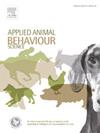Behavioural reactivity of indigenous and commercial lambs towards humans
IF 2.2
2区 农林科学
Q1 AGRICULTURE, DAIRY & ANIMAL SCIENCE
引用次数: 0
Abstract
Examining breed differences in farm animals is crucial for adopting the best management strategies to promote animal welfare and productivity. Hence, this study investigated whether two sheep breeds farmed in South Africa, one indigenous (Namakwa Afrikaners: NA) and one commercial breed (Dorper: DO), reacted differently when exposed to challenging situations. 323 NA and 358 DO ewe and ram lambs, aged 4 months, were tested over 7 years. These tests involved a stationary, seated human between them and their flock mates (arena test), a mobile human (docility test), and being constrained without the possibility of escape (‘scale test’). In the arena test, we calculated the mean distance from the seated operator and the distance travelled by the test animal. In the docility test, we recorded an individual animal's time to enter and be contained by a mobile handler in a square area of the test arena within 3 min. In the ‘scale-test,’ the animals' behavioural response was recorded using a 5-point scoring system (1 =calm; 5 =wild) at weighing. In all tests, vocalizations and urinations/defecations were recorded. During the arena test, the average distance to the human operator and time spent in the two areas closer to the human operator were independent of breed (P > 0.05). However, DO spent significantly more time in the section farthest from the stationary human (P < 0.05) than NA. Additionally, NA bleated more frequently (P < 0.0001) than DO, and ewes also bleated more than rams (P < 0.05). In the docility test, no difference was observed between breeds and sexes regarding the success of the test and the time contained (P > 0.05). However, NA sheep took longer to enter the marked area than DO (P < 0.05). Ewes also took longer than rams (P < 0.05). Furthermore, NA and ewes vocalized more than DO (P < 0.0001) and rams (P < 0.05). During the scale test, no difference was observed between breeds and sexes regarding the score allocated (P > 0.05), but NA bleated more than DO (P < 0.05). All variables from the three tests, except for success rate, time to enter, time contained and vocalizations from the docility test, varied between years (P < 0.05). Ewes and indigenous NA lambs demonstrated more anxiety in controlled situations, as indicated by their higher frequency of bleating. Therefore, flocks that include NA and/or ewes should be managed with caution, as they are more susceptible to stress during routine husbandry practices involving separation from peers.
求助全文
约1分钟内获得全文
求助全文
来源期刊

Applied Animal Behaviour Science
农林科学-行为科学
CiteScore
4.40
自引率
21.70%
发文量
191
审稿时长
18.1 weeks
期刊介绍:
This journal publishes relevant information on the behaviour of domesticated and utilized animals.
Topics covered include:
-Behaviour of farm, zoo and laboratory animals in relation to animal management and welfare
-Behaviour of companion animals in relation to behavioural problems, for example, in relation to the training of dogs for different purposes, in relation to behavioural problems
-Studies of the behaviour of wild animals when these studies are relevant from an applied perspective, for example in relation to wildlife management, pest management or nature conservation
-Methodological studies within relevant fields
The principal subjects are farm, companion and laboratory animals, including, of course, poultry. The journal also deals with the following animal subjects:
-Those involved in any farming system, e.g. deer, rabbits and fur-bearing animals
-Those in ANY form of confinement, e.g. zoos, safari parks and other forms of display
-Feral animals, and any animal species which impinge on farming operations, e.g. as causes of loss or damage
-Species used for hunting, recreation etc. may also be considered as acceptable subjects in some instances
-Laboratory animals, if the material relates to their behavioural requirements
 求助内容:
求助内容: 应助结果提醒方式:
应助结果提醒方式:


